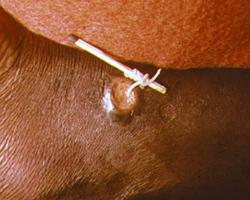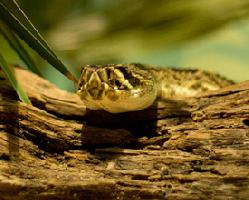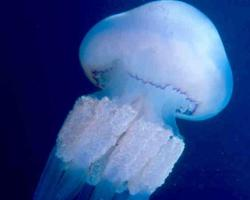
Veszélyeztetettség
| Rettenthetetlen |
Állatleírás
Dracunculus medinensis, commonly known as the Guinea worm, is a parasitic nematode that has plagued humans for thousands of years, known for its painful and debilitating infection process. This parasite is the causative agent of dracunculiasis, also referred to as Guinea worm disease, which has been a target of eradication efforts worldwide, particularly in rural areas of Africa. The lifecycle, symptoms, and historical context of this organism present a fascinating yet harrowing narrative of human interaction with parasitic diseases.The lifecycle of the Guinea worm is complex and involves two hosts: humans and small freshwater copepods, commonly known as water fleas. The process begins when a person consumes water contaminated with copepods harboring the infective larvae of D. medinensis. Once ingested, the stomach acid digests the copepods, releasing the larvae, which then penetrate the host's stomach or intestinal wall, entering the abdominal cavity and retroperitoneal space. Over the next year, the larvae mature into adult worms, which can measure 60 to 100 centimeters in length, making them among the longest nematodes infecting humans.
The hallmark of Guinea worm disease manifests as the female worm prepares to release her larvae. Approximately one year after infection, a painful blister forms on the skin, usually on the lower limbs, signaling the worm's emergence. This blister ruptures, exposing the worm, which can then be slowly and carefully extracted over several days or weeks by winding it around a small stick or piece of gauze. This extraction process is excruciatingly painful and often incapacitates the infected individual. If the worm breaks during extraction, it can cause severe inflammatory reactions, potentially leading to secondary infections.
Transmission of D. medinensis is intricately linked to water sources, making dracunculiasis a disease of poverty, closely associated with remote, rural communities lacking access to safe drinking water. The cycle perpetuates when individuals with an emerging worm enter water bodies, prompting the worm to release its larvae into the water, thereby contaminating it with the next generation of parasites.
Historically, Guinea worm disease has been a scourge of humanity, mentioned in ancient texts and observed in Egyptian mummies. However, through concerted public health efforts, including the provision of safe drinking water, education on filtering drinking water through fine mesh cloth to remove copepods, and containment of cases to prevent water contamination, the incidence of Guinea worm disease has dramatically decreased. The Carter Center, in particular, has been instrumental in these eradication efforts, which have brought the number of reported cases from millions in the 1980s to just a handful today.
Despite the remarkable progress towards eradication, challenges remain, including conflict, migration, and the difficulty of ensuring behavior change in affected populations. Guinea worm disease stands as a testament to the complexity of eradicating parasitic diseases but also showcases the potential for success through international cooperation, public health initiatives, and community engagement.
Hasonló állatok
Új állatfotók
Top 10 állat
- Dolphin gull (Leucophaeus scoresbii)
- Diana monkey (Cercopithecus diana)
- Moustached guenon (Cercopithecus cephus)
- Galápagos tortoise (Geochelone nigra complex)
- Japanese macaque (Macaca fuscata)
- Russian tortoise (Testudo horsfieldii)
- Stone loach (Barbatula barbatula)
- Greek tortoise (Testudo graeca)
- Common flying dragon (Draco volans)
- Vendace (Coregonus albula)


